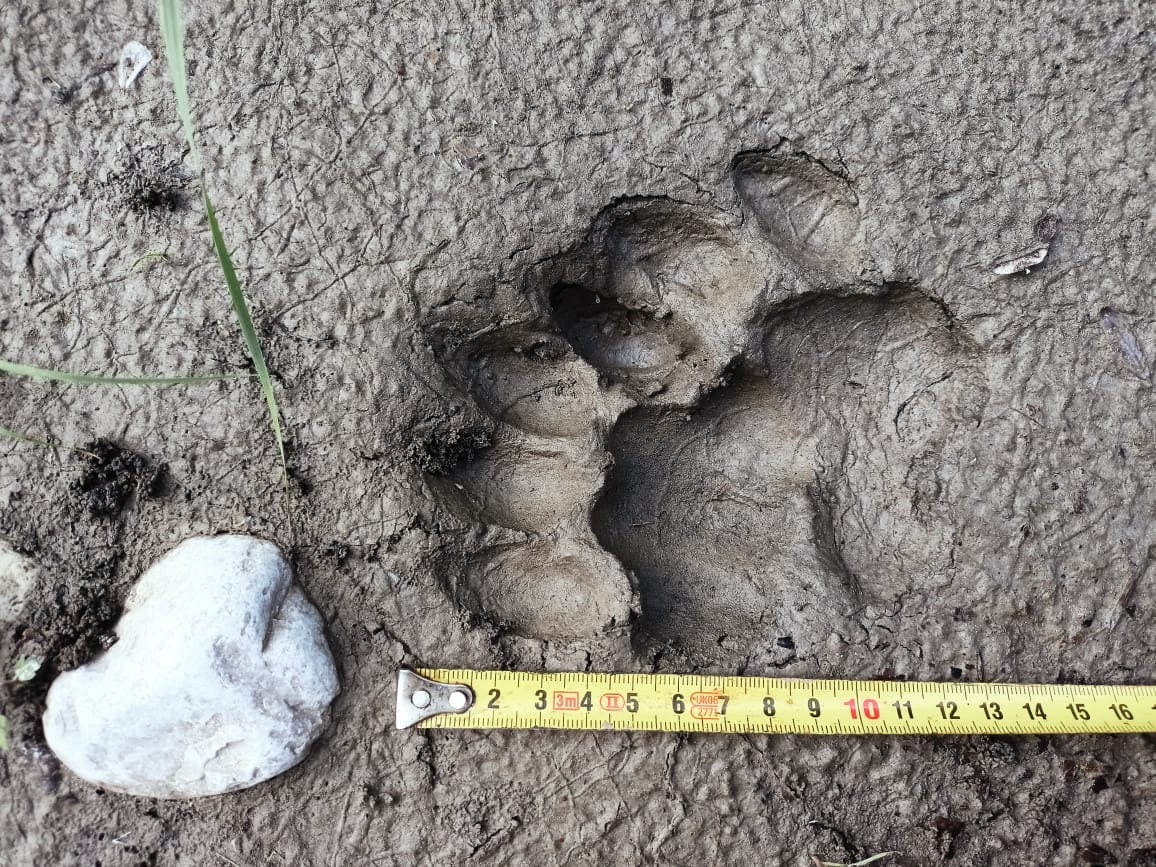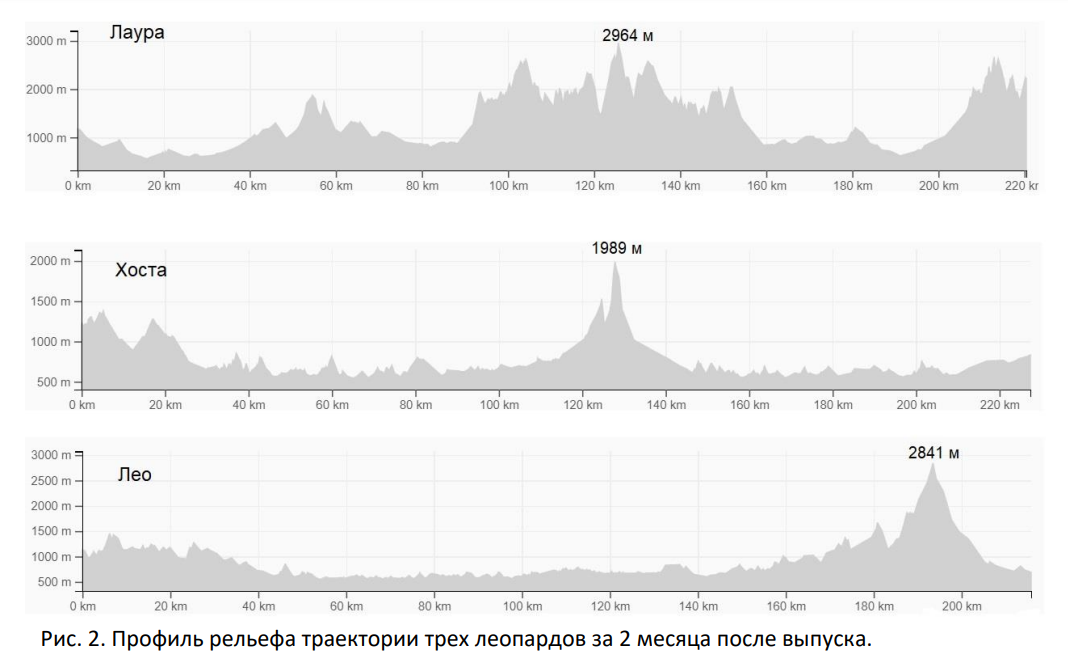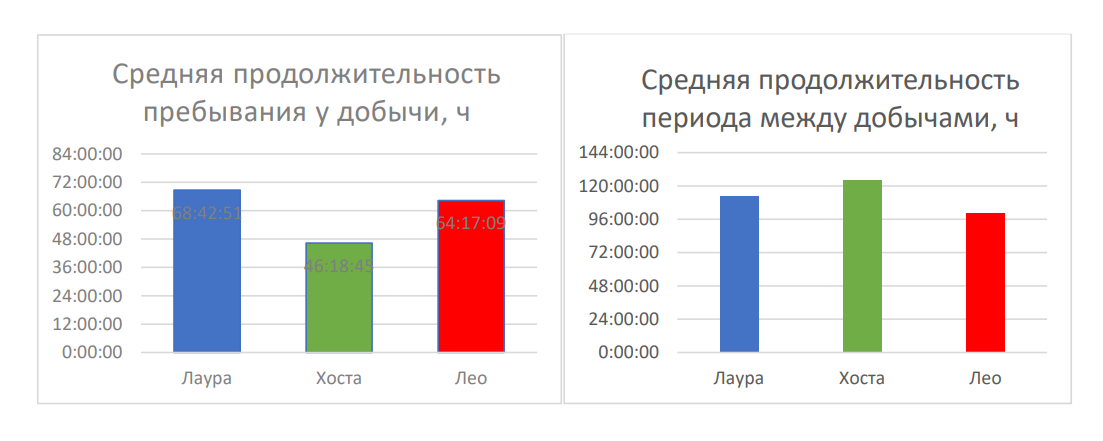
The leopards released in mid-July 2022 on the territory of North Ossetia-Alania have almost completely mastered the space of the Turmon forest. They gradually form habitats, where it is possible to identify the nuclear zones of the site (places where the probability of meeting an animal is highest). The relative position of the habitats of released leopards (a male and two females) is presented here (Fig. 1):

Use of space
At the moment, we can say that the ranges of the three leopards overlap by more than 50%. At the same time, the nuclear zones of the sites of females do not overlap at all, and the nuclear zones of the female Khosta and the male Leo overlap by more than 75%. In other words, the sisters Khosta and Laura separated after release and have little to do with each other. But the female Khosta is somewhat interested in the behavior of the male Leo and prefers to stay close to him and his habitat.
Laura. Laura has mastered an area of 161.3 sq. km (according to 826 locations received from the collar) and is still expanding the boundaries of her site. The nuclear zone of her site is already well formed, which indicates that she has decided on a comfort zone. Laura has studied these places very well and periodically returns to them. This part of its section is located at an altitude of at least 1000 m above sea level. with a ceiling at 2964 m.a.s.l.
Khosta. For Khosta, the habitat area covers an area of 150.8 square meters. km (according to 854 locations received from the collar). Like Laura, her zone is still expanding and still forming, but Khosta's is both in the core zone and in outer space. Most of the nuclear zone of its section is located below 1000 m a.s.l.
Leo. Leo has the largest habitat, which is typical for males. In terms of area, it is more than twice as large as the territories of females and occupies 370.7 square km (according to 854 locations received from the collar). Its section is also not yet fully formed, but the nuclear comfort zone is clearly defined. Leo, like Khosta, prefers altitudes below 1000 above sea level.
Movement
For two months of life in the wild, each of the leopards covered a distance of about 220 km (Laura - 220 km, Khosta - 227.6 km, Leo - 216 km). The elevation profile used by the animals is shown in fig. 2.

Hunting behavior and diet
Released leopards successfully prey on their natural prey species. Each of them harvested and ate at least 7 prey animals in the 57 days that have passed since the release. Experts checked the hunting grounds of leopards in the field mountain conditions after data were received from their collars, confirming that the leopard had left the place of eating the prey. The following animal species have been found as the main components of the diet of leopards: badgers, foxes, raccoon dogs, jackals, roe deer and red deer. The last one was the quarry of the male Leo. Female Laura confidently specializes in smaller ungulates (roe deer). Small predators (badgers, raccoon dogs, jackals, foxes) predominate in the diet of the female Khosta. Of the three leopards, the female Laura most fully utilizes her prey, she is not too lazy to overcome the longest distances in search of her roe deer, unlike Khosta and Leo, who spend their forces more carefully in search of prey. The longest breaks between hunts were noted by us for the female Khosta.

The Caucasian leopards released in North Ossetia, bred at the Leopard Restoration Center in the Caucasus of the Sochi National Park, are the basis for the formation of the core of a new population. Theoretically, at least 50 leopards should live on the territory of the Russian Caucasus. All released animals were specially tested before release for the ability to hunt and avoid encounters with humans.
The program for the restoration of the leopard in the Caucasus is being implemented by the Russian Ministry of Natural Resources with the participation of the Sochi National Park, the Caucasian Reserve, the North Ossetian Reserve, the Alania National Park, the Turmonsky Reserve of Regional Importance, the World Fund for Nature , the A.N. Severtsov Institute of Ecology and Evolution of the Russian Academy of Sciences (IEE RAS), A.K. Tembotov Institute of Ecology of Mountainous Territories RAS (IEGT RAS), Moscow Zoo, with the assistance of the International Union for Conservation of Nature (IUCN) and the European Association of Zoos and Aquariums (EAZA). The monitoring of the leopard in the Caucasus is financially supported by World Fund for Nature backer. In North Ossetia, RusHydro is providing financial support for the population recovery program.
